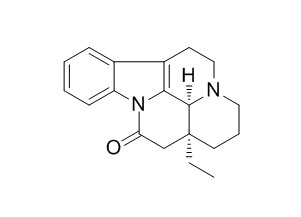(-)-Eburnamonine
(-)-Eburnamonine induced a superior improvement than Papaverine of some clinical symptoms (motor disorders, retrograde amnesia, vertigo) and of cortical bioelectrical activity. (-)-Eburnamonine enhanced the affinities for carbachol, bethanechol, furmethide, methylfurmethide, pentylthio-TZTP, pilocarpine, oxotremorine and oxotremorine-M on the M2 receptors.
Inquire / Order:
manager@chemfaces.com
Technical Inquiries:
service@chemfaces.com
Tel:
+86-27-84237783
Fax:
+86-27-84254680
Address:
1 Building, No. 83, CheCheng Rd., Wuhan Economic and Technological Development Zone, Wuhan, Hubei 430056, PRC
Providing storage is as stated on the product vial and the vial is kept tightly sealed, the product can be stored for up to
24 months(2-8C).
Wherever possible, you should prepare and use solutions on the same day. However, if you need to make up stock solutions in advance, we recommend that you store the solution as aliquots in tightly sealed vials at -20C. Generally, these will be useable for up to two weeks. Before use, and prior to opening the vial we recommend that you allow your product to equilibrate to room temperature for at least 1 hour.
Need more advice on solubility, usage and handling? Please email to: service@chemfaces.com
The packaging of the product may have turned upside down during transportation, resulting in the natural compounds adhering to the neck or cap of the vial. take the vial out of its packaging and gently shake to let the compounds fall to the bottom of the vial. for liquid products, centrifuge at 200-500 RPM to gather the liquid at the bottom of the vial. try to avoid loss or contamination during handling.
Srinakharinwirot University2023, 2669.
Res Pharm Sci.2023, 18(3):244-261.
Biochem Biophys Res Commun.2020, 530(1):4-9.
The Pharmaceutical Society of Japan2018, 138(4):571-579
Foods. 2022, 11(23):3905.
Plant Cell, Tissue and Organ Culture (PCTOC)2024, 158:54
Nutrients.2021, 13(10):3414.
Food Funct.2024, 15(4):1852-1866.
JPC-Journal of Planar Chromatography2023, 36:179-190
Journal of Ginseng Research2021, 3 June.
Related and Featured Products
Rivista Di Neurologia, 1983, 53(1):15.
Clinical and electrophysiologic changes produced by (-)-eburnamonine in acute and post-acute stages of head injuries.[Reference:
WebLink]
METHODS AND RESULTS:
Two groups of patients suffering from cranial trauma have been submitted to a double-blind acute (1-2 per phlebo ampules/die for 7-10 days) and chronic (1 i.m. ampule for 30 days) at random treatment, respectively with (-)-Eburnamonine and Papaverine. The evaluation of the clinical symptoms (state of consciousness, neurologic and post-traumatic symptoms) and of some electrophysiological responses (REG, visual and somato-sensorial evoked potentials) were investigated in basal conditions, during the acute stage, at the end of the chronic treatment and 30 days after the drugs withdrawal.
The results showed (-)-Eburnamonine to induce a superior improvement than Papaverine of some clinical symptoms (motor disorders, retrograde amnesia, vertigo) and of cortical bioelectrical activity, as rheoencephalographic data and reduction in early latencies of evoked response to somato-sensorial stimulation (SEP) revealed.
CONCLUSIONS:
Local and systemic tolerability was good with both drugs; a slight hypotensive action, more marked with Papaverine, was noted at the end of the treatment.
Molecular Pharmacology, 1997, 52(1):172-179.
Positive cooperativity of acetylcholine and other agonists with allosteric ligands on muscarnic acetylcholine receptors.[Reference:
WebLink]
It is well known that allosteric modulators of muscarinic acetylcholine receptors can both diminish and increase the affinity of receptors for their antagonists.
METHODS AND RESULTS:
We investigated whether the allosteric modulators can also increase the affinity of receptors for their agonists. Twelve agonists and five allosteric modulators were tested in experiments on membranes of CHO cells that had been stably transfected with genes for the M1-M4 receptor subtypes. Allosterically induced changes in the affinities for agonists were computed from changes in the ability of a fixed concentration of each agonist to compete with [3H]N-methylscopolamine for the binding to the receptors in the absence and the presence of varying concentrations of allosteric modulators. The effects of allosteric modulators varied greatly depending on the agonists and the subtypes of receptors. The affinity for acetylcholine was augmented by (-)-Eburnamonine on the M2 and M4 receptors and by brucine on the M1 and M3 receptors. Brucine also enhanced the affinities for carbachol, bethanechol, furmethide, methylfurmethide, pilocarpine, 3-(3-pentylthio-1,2,5-thiadiazol-4-yl)-1,2,5,6-tetrahydro-1- methylpyridine (pentylthio-TZTP), oxotremorine-M, and McN-A-343 on the M1, M3, and M4 receptors, for pentylthio-TZTP on the M2 receptors, and for arecoline on the M3 receptors.
(-)-Eburnamonine enhanced the affinities for carbachol, bethanechol, furmethide, methylfurmethide, pentylthio-TZTP, pilocarpine, oxotremorine and oxotremorine-M on the M2 receptors
and for pilocarpine on the M4 receptors. Vincamine, strychnine, and alcuronium displayed fewer positive allosteric interactions with the agonists, but each allosteric modulator displayed positive cooperativity with at least one agonist on at least one muscarinic receptor subtype. The highest degrees of positive cooperativity were observed between (-)-Eburnamonine and pilocarpine and (-)-Eburnamonine and oxotremorine-M on the M2 receptors (25- and 7-fold increases in affinity, respectively) and between brucine and pentylthio-TZTP on the M2 and brucine and carbachol on the M1 receptors (8-fold increases in affinity).
CONCLUSIONS:
The discovery that it is possible to increase the affinity of muscarinic receptors for their agonists by allosteric modulators offers a new way to subtype-specific pharmacological enhancement of transmission at cholinergic (muscarinic) synapses.



